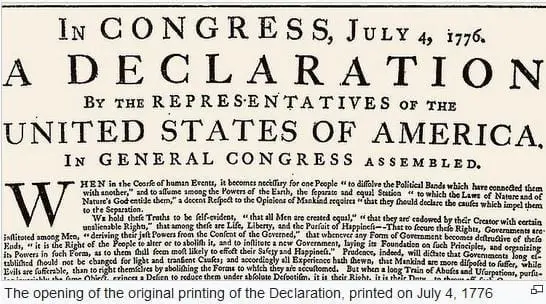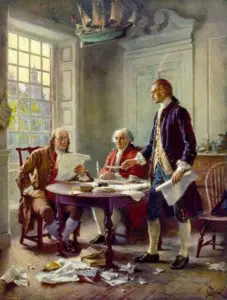The beaches in Westerly will be full on this beautiful fourth of July. Independence Day is always one of the busiest holidays of the year here. So what exactly happened on the fourth of July? The date commemorates the adoption of the Declaration of Independence 242 years ago, on July 4, 1776. The Continental Congress declared that the thirteen American colonies regarded themselves as a new nation, the United States of America, and were no longer part of the British Empire. Congress actually voted to declare independence two days earlier, on July 2.
That’s right, during the American Revolution the legal separation of the 13 Colonies from Great Britain actually occurred on July 2, 1776. The Second Continental Congress voted to approve a resolution of independence that had been proposed in June by Richard Henry Lee of Virginia declaring the United States independent from Great Britain’s rule.
After voting for independence Congress turned its attention to the Declaration of Independence, a statement explaining this decision, which had been prepared by a Committee of Five with Thomas Jefferson as its principal author. Congress debated and revised the wording of the Declaration, finally approving it two days later on July 4, 1776.
A day earlier, John Adams had written to his wife Abigail saying, “The second day of July, 1776, will be the most memorable epoch in the history of America. I am apt to believe that it will be celebrated by succeeding generations as the great anniversary festival. It ought to be commemorated as the day of deliverance, by solemn acts of devotion to God Almighty. It ought to be solemnized with pomp and parade, with shows, games, sports, guns, bells, bonfires, and illuminations, from one end of this continent to the other, from this time forward forever more.”
Adams’s prediction was off by two days. From the outset Americans celebrated independence on July fourth, the date shown on the much-publicized Declaration of Independence, rather than on July second, which is the date the resolution of independence was approved in a closed session of Congress.
Historians have long disputed whether members of Congress signed the Declaration of Independence on the fourth of July even though Thomas Jefferson, John Adams, and Benjamin Franklin all later wrote that they had signed it on that day. Most historians have concluded that the Declaration was signed nearly a month after its adoption on August 2, 1776, and not on July fourth as is commonly believed.
To complicate matters even more, on May 4, 1776 the Rhode Island General Assembly repealed a rule that government officers swear allegiance to the King. This was in effect a declaration of independence almost two months before the fourth of July, which made Rhode Island the first colony to declare independence. Ironically, Rhode Island would be the last state to ratify the new American Constitution more than 14 years later, on May 29, 1790.
Coincidentally, both John Adams and Thomas Jefferson, the only signers of the Declaration of Independence to later serve as Presidents of the United States, died on the same day, July 4, 1826, which was the 50th anniversary of the Declaration. Although not a signer of the Declaration of Independence, James Monroe, another Founding Father who was elected as President, also died on the fourth of July in 1831. He was the third President in a row who died on the anniversary of independence.
So when you make plans to celebrate Independence Day and invite friends over to fire up the grill or head to the beach, make sure you tell everyone which day that is – and in Rhode Island that could be May 4, July 2, July 4, or August 2. Happy Independence Day!







